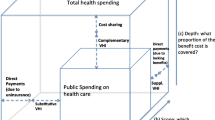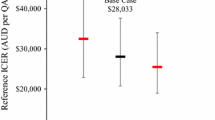Abstract
A recent integrated health care initiative in Belgium supports 12 regional pilot projects scattered across the country and representing 21% of the population. As in shared savings programs, part of the estimated savings in health spending are paid out to the projects to reinvest in new actions. Short-term savings are expected in particular from cost reductions among high-cost patients. We estimate the effect of the projects on spending using a difference-in-difference model. The sensitivity of the results to the right-skewness of spending is commonly addressed by removing or top-coding high-cost cases. However, this leads to an underestimation of realized savings at the top end of the distribution, therefore, lowering incentives for cost reduction. We show that this trade-off can be weakened by an alternative approach in which cost categories that fall out of the scope of the projects’ interventions are excluded from the dependent variable. We find that this approach leads to improvements in precision and model fit that are of the same magnitude as excluding high-cost cases altogether. At the same time, it sharpens the incentives for cost reduction because the model better reflects the costs that projects can affect.


Similar content being viewed by others
Notes
The subsidy corresponds to the salary of one full-time employee plus overhead.
Some examples of these interventions are: avoiding duplication of services, e.g. of blood sample or medical images; preventive interventions such as fall prevention in the elderly; follow-up care such as after patients’ discharge from a hospital; patient self-management such as medication schedules.
Because the estimations did not yield significant results, payments based on savings have been suspended for the first two years of the program (2018–2019).
The downside of this approach is that individuals who move to another region, transfer previous incentives that might affect health care use to another group. Another approach used in some evaluations is to limit the sample to the cohort that can be assigned to a particular group over the entire period of analysis. However, over an 8-year pre- and postintervention period, this would lead to a high percentage of exclusions, including an important target group of integrated care interventions, in particular older persons who die before the end of the evaluation period.
In addition to reimbursed and out-of-pocket payments, there are also supplements. Supplements are the difference between the actual rate and the conventional rate for services included in the compulsory health insurance system, or for the full price for care services not included in that system. Supplements in hospitals are regulated to a certain extent, but in the ambulatory sector providers have a large degree of freedom to determine them.
The mean absolute error avoids the disadvantage of R-square type measures that outliers are heavily weighted.
As an instrument to control hospital drugs costs, medication during hospital stays is reimbursed on the basis of a fixed payment per patient-day (per diem). However, a number of mostly expensive and/or innovative drugs are reimbursed on a fee-for-service basis. These drugs are defined by their active substance (5th level of ATC classification).
The values of the 99.9th and 99th percentile are about 19 and 11 times the mean cost.
References
De Ridder, R., Bourgeois, J., Van den Bogaert, S., Van der Brempt, I.: Implementing integrated care in Belgium: a nationwide mobilization. Int. J. Integr. Care (2017). https://doi.org/10.5334/ijic.3441
Wagner, E., Austin, B., Von Korff, M.: Organizing care for patients with chronic illness. Milbank Q. 74(4), 511–544 (1996)
Paulus, D., Van den Heede, K., Mertens R.: Position paper: organisatie van zorg voor chronisch zieken in België. Brussels, KCE Report 190A (2012)
Bailit, M., Hughes, C.: Key design elements of shared-savings payment arrangements. The commonwealth fund issue brief. http://www.bailit-health.com/publications/082111_bhp_key_designelements_sharedsavings.pdf (2011). Accessed 2 Apr 2021
Medicare Shared Savings Program: Shared savings and losses and assignment methodology. https://www.cms.gov/files/document/shared-savings-losses-assignment-spec-v8.pdf-0 (2020). Accessed 2 Apr 2021
Vats, S., Ash, A., Ellis, R.: Bending the cost curve? Results from a comprehensive primary care payment pilot. Med. Care 51(11), 964–969 (2013). https://doi.org/10.1097/MLR.0b013e3182a97bdc
Nolte, E., Pitchforth, E.: What is the evidence on the economic impacts of integrated care?. Technical Report. World Health Organization, Copenhagen, Denmark. https://researchonline.lshtm.ac.uk/id/eprint/2530944 (2014). Accessed 2 Apr 2021
Busse, R., Stahl, J.: Integrated care experiences and outcomes in Germany, the Netherlands, and England. Health Aff. (2014). https://doi.org/10.1377/hlthaff.2014.0419
Peckham, A., Rudoler, D., Allin, S., Bhatia, D., Abdelhalim, R., Kavelaars, R.A., Marchildon, G.: Accountable care organizations: success factors, provider perspectives and an appraisal of the evidence. North American Observatory on Health Systems and Policies, Toronto. Rapid review (no. 12) (2019)
Song, Z., Safran, D.G., Landon, B.E., Landrum, M.B., He, Y., Mechanic, R.E., Day, M.P., Chernew, M.E.: The ‘Alternative Quality Contract’, based on a global budget, lowered medical spending and improved quality. Health Aff. 31(8), 1885–1894 (2012). https://doi.org/10.1377/hlthaff.2012.0327
Song, Z., Rose, S., Safran, D.G., Landon, B.E., Day, M.P., Chernew, M.E.: Changes in health care spending and quality 4 years into global payment. N. Engl. J. Med. 371, 1704–1714 (2014). https://doi.org/10.1056/NEJMsa1404026
Song, Z., Ji, Y., Safran, D.G., Chernew, M.E.: Health care spending, utilization, and quality 8 years into global payment. N. Engl. J. Med. 381, 252–263 (2019). https://doi.org/10.1056/NEJMsa1813621
McWilliams, J.M., Landon, B.E., Chernew, M.E.: Changes in health care spending and quality for Medicare beneficiaries associated with a commercial ACO contract. JAMA 310(8), 829–836 (2013). https://doi.org/10.1001/jama.2013.276302
McWilliams, J.M., Hatfield, L., Landon, B.E., Hamed, P., Chernew, M.E.: Medicare spending after 3 years of the Medicare Shared Savings Program. N. Engl. J. Med. 379, 1139–1149 (2018). https://doi.org/10.1056/NEJMsa1803388
McGuire, T.G., van Kleef, R.C.: Risk sharing. In: McGuire, T.G., van Kleef, R.C. (eds.) Risk Adjustment, Risk Sharing and Premium Regulation in Health Insurance Markets: Theory and Practice, pp. 105–132. Academic Press, Cambridge (2018)
Jones, A.M.: Models for health care. In: Clement, M.P., Hendry, D.F. (eds.) The Oxford Handbook of Economic Forecasting. Oxford University Press, Oxford (2011)
Ellis, R.P., Martins, B., Sherri, R.: Risk adjustment for health plan payment. In: McGuire, T.G., van Kleef, R.C. (eds.) Risk Adjustment, Risk Sharing and Premium Regulation in Health Insurance Markets: Theory and Practice, pp. 55–104. Academic Press, Cambridge (2018)
Manning, W., Mullahy, J.: Estimating log models: to transform or not to transform? J. Health Econ. 20, 461–494 (2001). https://doi.org/10.1016/S0167-6296(01)00086-8
Hayen, A.P., van den Berg, M.J., Meijboom, B.R., Struijs, J.N., Westert, G.P.: Incorporating shared savings programs into primary care: from theory to practice. BMC Health Serv. Res. (2015). https://doi.org/10.1186/s12913-015-1250-0
Angrist, J.D., Pischke, J.S.: Mostly Harmless Econometrics. An Empiricist’s Companion. Princeton University Press, Princeton (2009)
Wooldridge, J.: Econometric Analysis of Cross Section and Panel Data. MIT Press, Cambridge (2001)
Schokkaert, E., Guillaume, J., van de Voorde, C.: Risk adjustment in Belgium: why and how to introduce socioeconomic variables in health plan payment. In: McGuire, T.G., van Kleef, R.C. (eds.) Risk Adjustment, Risk Sharing and Premium Regulation in Health Insurance Markets: Theory and Practice, pp. 209–232. Academic Press, Cambridge (2018)
Acknowledgements
This paper reports results that are obtained within a project between the Belgian Health Authorities and IMA (Intermutualistic Agency). The authors alone are responsible for its content. We thank the participants of the 2020 RAN-workshop, in particular Randy Ellis and Tom McGuire, for valuable comments.
Author information
Authors and Affiliations
Corresponding author
Additional information
Publisher's Note
Springer Nature remains neutral with regard to jurisdictional claims in published maps and institutional affiliations.
Appendices
Appendix 1: List of covariates
Socio-demographic and -economic variables.
-
Sex-age categories (0; 1–25; 26–50; 51–75; 75+ year)
-
Deceased in year t
-
Single
-
Self-employed
-
Entitled to increased compensation
-
Dependent on subsistence level income or social welfare
Care dependence variables (based on insurance entitlements).
-
Unable to work (occupationally disabled)
-
Disabled
-
Disabled and care dependent
-
Heavily care-dependent patient receiving long-term nursing care at home (3 levels of dependency)
-
Receiving physiotherapy for severe pathology
-
Receiving rehabilitation therapy
Morbidity indicators based on ambulatory and inpatient drug prescriptions.
-
Cardiovascular disease—general
-
Cardiovascular disease—heart disease
-
Thrombosis—anticoagulants
-
Chronic obstructive pulmonary disease (COPD)
-
Asthma
-
Diabetes with cardiovascular disease
-
Psoriasis
-
Crohn's disease, Colitis Ulcerosa, Psoriatic arthritis, Rheumatoid arthritis
-
Psychoses in persons of 70 years and less
-
Psychoses in persons over 70 years of age
-
Parkinson's disease
-
Epilepsy and neuropathic pain
-
HIV
-
Multiple sclerosis
-
Alzheimer's disease
-
Hepatitis B or C
-
Thyroid disorders
-
Exocrine pancreatic disease
Morbidity indicators based on ambulatory and inpatient drug prescriptions and on use of care and facilities for specific conditions.
-
Diabetes mellitus with insulin
-
Kidney failure
-
Cancer
-
Hemophilia
-
Cystic fibrosis
-
MS/ALS/Huntington
Geographical variables.
-
Region (Brussels, Flanders, Wallonia)
-
Level of urbanization of municipality
-
Level of medical supply of municipality
Appendix 2: Parallel pretrends
See Fig. 3.
Mean spending (in euro) in the pilot projects (solid lines) and in the risk-adjusted control groups (dotted lines). Dependent variable as in specification 2—baseline (see Table 4: two subsets of medication are excluded)
Rights and permissions
About this article
Cite this article
Geurts, K., Bruijnzeels, M. & Schokkaert, E. Do we care about high-cost patients? Estimating the savings on health spending by integrated care. Eur J Health Econ 23, 1297–1308 (2022). https://doi.org/10.1007/s10198-022-01431-3
Received:
Accepted:
Published:
Issue Date:
DOI: https://doi.org/10.1007/s10198-022-01431-3





